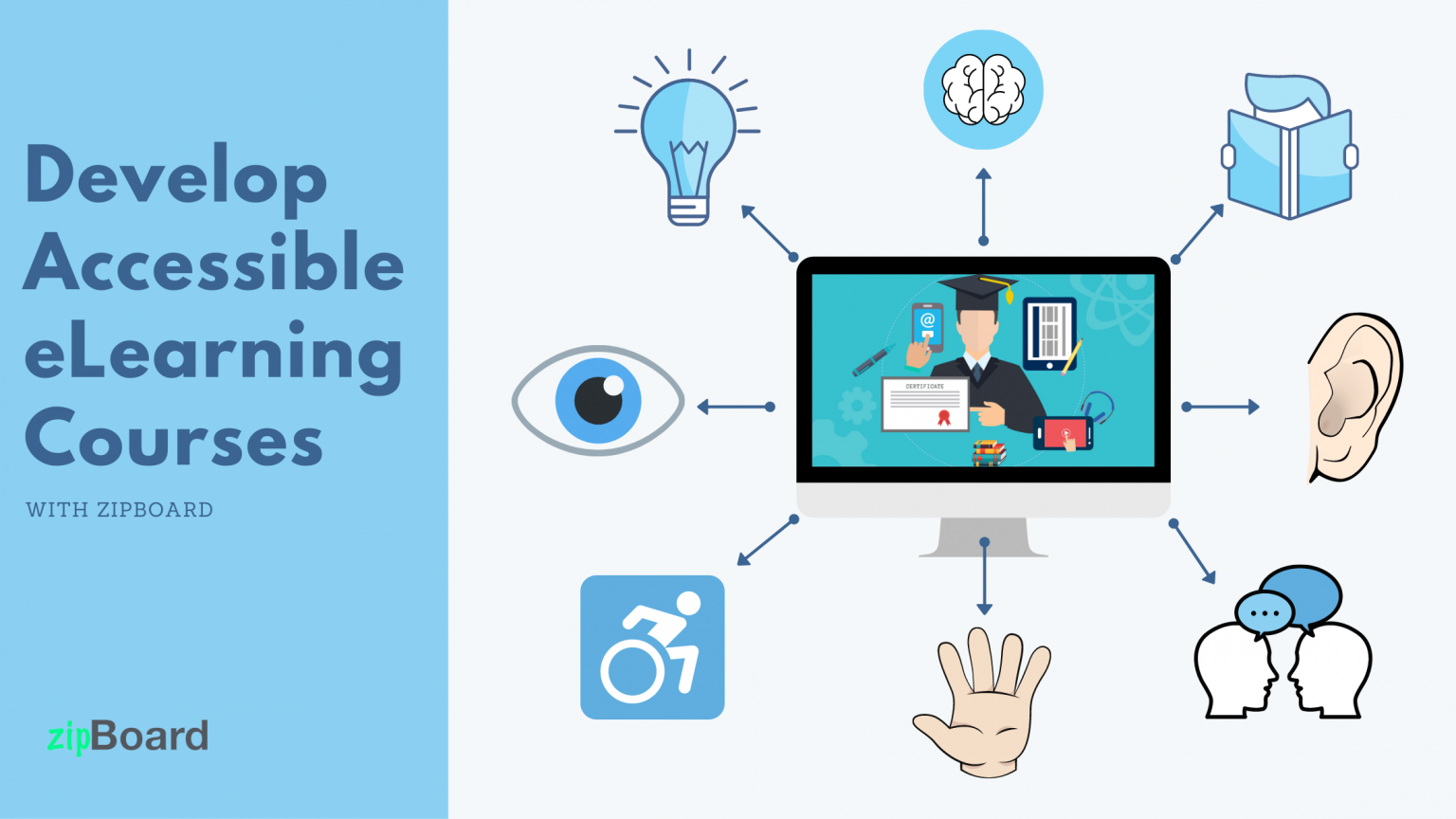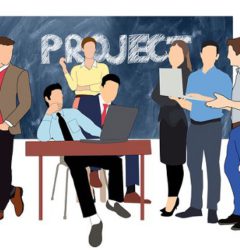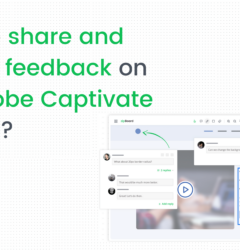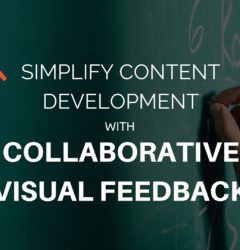Designing Accessible eLearning Courses
25 Sep

Table of Contents
ToggleAccessibility eLearning development has evolved from Web accessibility. Web accessibility is about making content, applications, websites, or any form of digital content that can be accessed over the internet by anyone from any place in the world.
But what does accessibility have to do with content, especially eLearning content? For starters, there are 7.8 billion people in the world and not everyone is similar. That implies that there are people with special challenges. But given we all love to consume content, we must make content that can be consumed by everyone, even the ones who are specially challenged.
Web accessibility has derived some standards to make it possible for companies to create content that can be consumed by everyone. These standard guidelines are also necessary as many countries have laws to ensure that the eLearning content is as per this standard.
After all eLearning development is about creating meaningful content to improve skills and knowledge, which in turn can improve human life. And so all human beings should be provided with the same knowledge.
Why accessible eLearning courses?
Accessible eLearning content provides a better and equal learning experience to everyone. It is often thought developing content with the accessibility guidelines helps specially challenged learners, but that is not true. Accessibility eLearning benefits everyone, it makes it easier to perceive, understand, navigate, and interact with the course.
In our day-to-day lives, there are circumstances when we face challenges accessing the course. For example, they have old hardware or software, there could be a bad internet connection, people who are suffering temporary illness and not able to work as efficiently as they used to, maybe someone met with an accident is unable to use some part of their body due to injury. There could be many more scenarios where people who do are having any kind of disability can find it challenging to access courses. In simple words, at least one person is directly or indirectly disabled in every learning group.
“The American Community Survey (ACS) estimates the overall rate of people with disabilities in the US population in 2016 was 12.8%. … For those ages 5-17, the rate was 5.6%. For ages 18-64, the rate was 10.6%. For people ages 65 and older, 35.2% had a disability.”
Source – 2017 Disability Statistics Annual Report
One in four American adults has a disability as per the 2016 Behavioral Risk Factor Surveillance System (BRFSS).
Per the CDC, one in four American adults has a disability. 26 percent which is about 61 million adults in the United States live with a disability
According to the World Health Organization (WHO), more than one billion people (that’s 15% of the world!) live with some type of disability. Dyslexia alone affects around 10% of the population to some degree, making it one of the most common forms of learning challenges today.
What is Disability? And the common types of disabilities?
A disability is a physical, mental, cognitive, or developmental condition that impairs, interferes with, or limits a person’s ability to participate, access, and interact in typical daily activities. A disability could be by birth where someone is born with challenges and in most cases will be there for a lifetime. Or disability could also be temporary and might have occurred due to unforeseen circumstances or accidents.
In either case, disability can be of various types and can affect the individual differently.
Let’s look at some recognizable and unrecognizable disabilities and know more about them.
- Vision (Blindness, Low Vision, Color Blindness)
- Hearing (Deafness, Hard of Hearing)
- Mobility (Spinal Cord Injury, Broken Limb, Cerebral Palsy)
- Speech (Speech Impediment, Unable to speak)
- Cognitive (Memory, Problem Solving, Attention)
- Neural (Seizure, Multiple Sclerosis)
How Accessibility eLearning development can help people with disabilities?
Developing your eLearning content to be accessible means that your content has been designed to be used by anyone. Let’s take a look at how to develop content for the most common types of disability so that your eLearning course is accessible by everyone.
Consistent Navigation
Irrespective of whether a person is disabled or not, there is a learning curve that an individual goes through when engaging with eLearning content.
Vision (Blindness, Low Vision, Color Blindness)
Your content has to look well organized and structured to make it more easily readable. People with visual impairments often rely on screen readers to read what is there on the screen. And screen readers read the markup and not the page show visually on the screen. So it’s important to keep it simple and clean to easily read.
Do’s
- Use simple, bold fonts that are at least 14pt in size.
- Use correct style and format, bold titles, different level to header H1, H2, H3
- Use a bulleted list instead of using a hyphen
- Use bold for importance, italic for emphasis, and blockquote for call-outs or quotes instead of using color to highlight important text.
- Ensure there is sufficient contrast dark and light between visual elements.
- Use alt tags for images.
Don’ts
- Do not hide your content within tabs or a dropdown list. Instead, put a list of points that can be seen. This is also helpful when a learner is dependent on a screen reader to describe what is there on the screen. Screen readers cannot access and read from a drop-down list.
- Avoid using color to differentiate your content, as people with color blindness may not be able to discern the difference in content easily.
- Don’t use tables to style the content unless you are representing data in the table. Eg. instead of using tables to show “Do’s” on one side and Don’ts on the other side of the table. Simply put it one by one under their respective headers.
Better organizing of content makes it easily discernible for users with limited vision or visual learning disabilities.
Hearing (Deafness, Hard of Hearing)
People with hearing impairment tend to engage with eLearning content with more ease than people who are visually impaired. Still not being able to hear the audio is a challenge, so here are some tips to help individuals with this disability.
- Make sure to add captions for every video, especially wherever there is some kind of spoken explanation about the topic.
- For every video or audio format content offers written transcriptions. Transcriptions are not just helpful for people with hearing difficulties but it is helpful for everyone. It makes taking notes and revising the topic easy.
Mobility (Spinal Cord Injury, Broken Limb, Cerebral Palsy)
Physical or Mobility Impairment restricts an individual from proper physical coordination of different organs or parts of the body. Disability in mobility can be by birth or acquired with age or in some cases caused due to some accidents. Persons with mobility disabilities often need assistive devices to help them do any form of physical activity.
eLearning courses are specifically beneficial to people with mobility disorders as they do not have to make travel arrangements or attend workshops or classes in crowded rooms.
There is one important tip here to make a note while developing accessible eLearning content, keeping in mind the needs of mobility disorder persons. It is if the course contains any drag and drop actions to be completed by the learner to try to first see and remove it. If not, let’s say it’s a crucial part of the content then try to at least provide keyboard shortcuts for the ones who need them.
Speech (Speech Impediment, Unable to speak)
For the live eLearning courses, there might be a need for participants to engage with other participants or instructors. To assist people impaired with speech disability allow participants to be able to communicate using text (message and comments). Check if they have a question or have something to share and allow them some time to write their thoughts.
Another scenario is when an eLearning course demands the learner to input voice-based commands or repeat certain words, to engage or interact with the content. In such scenarios, there should be an additional provision for people with a speech impairment to be able to use text-based input.
For eg. Type “I understand” if you understand this topic.
Cognitive (Memory, Problem Solving, Attention)
Cognitive Impairment is when a person has difficulty concentrating, remembering, learning new things, or making decisions in their everyday activities.
Accessibility eLearning development can assist such individuals to better grasp, retain, and implement what they learn. Ask yourself this question while designing your content.
- Is the content easy to understand/comprehend?
- If a problem arises, is it easy to solve?
- Can learners easily recall or recognize information?
- Is the task learners are asked to complete doable?
- Is the reading level appropriate for my audience?
Neural (Seizure, Multiple Sclerosis)
Neural disability is a condition caused by a dysfunction in part of the brain or nervous system, that results in physical or psychological disorders. All neurological disorders include the brain, spinal column, or nerves. And it can have a wide and varied range of causes, complications, and outcomes.
Some examples of neural disability are
- Cerebral palsy
- ADHD (Attention Deficit Hyperactivity Disorder)
- Autism
- Meningitis
- Stroke, Trauma, Hypoxia
Here is a detailed guide on what is a neurologic disorder, if you want to know more about it.
For addressing the challenges of people with this group of disabilities it is suggested that you make the content accessible for the previously discussed challenges. Most of those points would be helpful for people with Neural disabilities.
What is IDEA (Individuals with Disabilities Education Act)
IDEA was created to provide children with disabilities the same opportunity for education as is given to those who do not have a disability. Individuals with Disabilities Education Act is a part of the American legislation. This law makes it legally applicable to create an eLearning course as per the guidelines set by the IDEA so that it solves the purpose of ensuring children with disabilities get equal learning opportunities. And that the disability of students should not be a hindrance in their education. It also makes sure that students with a disability get Free Appropriate Public Education (FAPE).
Get ready to design accessible eLearning courses.
Building great courses for people with special needs requires that we understand the needs of the learners. Fix things once the course is already completed can become too much work.
If you can visually communicate over the course content it will make life easier for the eLearning developers and the outcome will be an accessible eLearning course.
- zipBoard is a simple eLearning review tool suitable for non-technical stakeholders as well. It’s an online whiteboard for issue tracking and collaborating with your team.
- Review your course on different screen resolutions.
- Works for responsive authoring tools as well.
- Go beyond the slide based eLearning review tool.
- File bugs for specific resolution right from your browser, your own computer.
- Add various file formats for review.
- Being able to video record any defect or issue.
Manage multiple project with multiple collaborators from one single cloud based collaborative visual review, bug tracking and client feedback management software.
Enhance your eLearning Accessibility Reviews with zipBoard
Start your free trial or book a demo today so that we can create a tailored solution for you.
Book DemoStart Free TrialRecent Posts
- Best Practices for Efficient Document Reviews and Collaboration December 18, 2025
- MEP Document Management: How to Streamline Reviews & Avoid Rework October 3, 2025
- What Is Online Proofing Software? And Why Content Review Breaks Without It July 11, 2025
- How Laerdal Medical Cut eLearning Review Time by 50% with zipBoard’s Visual Review Tool July 9, 2025
- Why Your Team Needs a Content Feedback System (Not Just Comments in Docs) May 28, 2025
©️ Copyright 2025 zipBoard Tech. All rights reserved.


